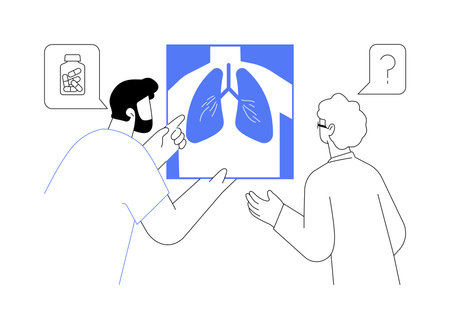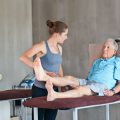1. Understanding the Psychological Toll of Chronic Cardiac and Pulmonary Disease
Living with chronic heart and lung conditions, such as heart failure, coronary artery disease, COPD (chronic obstructive pulmonary disease), and asthma, can have a significant impact on a person’s mental well-being. In the United States, millions of people face these health challenges every day. Dealing with ongoing symptoms like shortness of breath, chest pain, fatigue, and frequent doctor visits doesn’t just affect the body—it takes a toll on the mind too.
How Chronic Illness Affects Mental Health
When someone is diagnosed with a chronic cardiac or pulmonary condition, daily routines often change dramatically. Many people start to feel anxious about their health or experience sadness about lost independence. The uncertainty about the future and fear of medical emergencies can lead to persistent worry or even panic attacks. Over time, this stress can turn into depression or make existing mental health issues worse.
Common Psychological Effects in Heart and Lung Disease
| Psychological Effect | Description | How It Impacts Daily Life |
|---|---|---|
| Anxiety | Feeling nervous, restless, or constantly worried about health issues. | Makes it harder to relax, sleep, or participate in social activities. |
| Depression | Feelings of sadness, hopelessness, or lack of interest in activities. | Lowers motivation for self-care, exercise, and connecting with others. |
| Stress | Emotional tension from managing symptoms and treatments. | Can cause headaches, muscle tension, and worsen physical symptoms. |
Why These Feelings Are Common in American Society
In American culture, there is often pressure to stay active, independent, and productive. When chronic illness makes these things more difficult, people may feel isolated or like they’re letting themselves or their families down. Medical bills and navigating insurance can add extra stress for many Americans. Plus, talking about mental health isn’t always easy—some may worry about being judged or misunderstood by others.
The Cycle of Physical Symptoms and Emotional Distress
The relationship between chronic illness and mental health can become a cycle: physical symptoms increase anxiety and stress levels, which in turn can make symptoms feel worse. For example, shortness of breath can trigger panic attacks; worrying about another attack might cause people to avoid activities they used to enjoy. Breaking this cycle is an important part of managing both physical and mental health conditions.
2. Recognizing Symptoms: Anxiety and Stress in Chronic Illness
Understanding the Connection Between Mind and Body
Living with chronic cardiac or pulmonary diseases, like heart failure or COPD, goes far beyond managing physical symptoms. Many Americans experience psychological challenges such as anxiety and stress as part of their daily lives. These feelings are not just “in your head”—they are real and can impact how you feel physically, too. Recognizing these symptoms early is a key step in taking control of your health.
Common Psychological Symptoms in Cardiac and Pulmonary Disease
People with chronic heart or lung conditions often face unique emotional struggles. Here’s a quick look at some common psychological symptoms:
| Symptom | How It May Show Up |
|---|---|
| Anxiety | Feeling restless, racing thoughts, trouble sleeping, increased heart rate, shortness of breath (even when medically stable) |
| Stress | Muscle tension, headaches, fatigue, irritability, difficulty concentrating, changes in appetite |
| Depression | Lack of motivation, persistent sadness, withdrawing from family or social activities, feeling hopeless about recovery |
| Panic Attacks | Sudden intense fear, chest pain, sweating, shaking—sometimes mistaken for worsening heart or lung symptoms |
How These Symptoms Appear in Daily Life
Anxiety and stress can affect many aspects of everyday living. For example, you might avoid physical activity because you’re afraid it will trigger shortness of breath. You may worry constantly about your next doctor’s appointment or feel overwhelmed by medication routines. Even simple tasks like grocery shopping can become stressful if you’re concerned about fatigue or breathing problems.
Why Recognizing Symptoms Matters
If you know what to look for, you can take action sooner—whether that means talking to your doctor, reaching out to a support group, or trying relaxation techniques like breathing exercises. Remember: mental and physical health go hand-in-hand. By learning to spot these signs early on, you’re taking a proactive step toward better overall well-being.

3. Why Breathing Exercises Matter: The Mind-Body Connection
Living with chronic cardiac and pulmonary disease often means facing more than just physical symptoms. Many people also experience high levels of stress, anxiety, and even depression as they manage their condition day in and day out. In the United States, theres growing recognition of the deep connection between our minds and bodies—especially when it comes to how we breathe.
The Science Behind Breathwork
Breathing is something we all do without thinking, but it actually has a powerful influence on our nervous system. When you feel anxious or stressed, your breathing often becomes shallow and rapid. This can trigger your bodys “fight or flight” response, making stress and anxiety feel even worse. On the other hand, slow and controlled breathing sends a signal to your brain that its safe to relax. This activates your parasympathetic nervous system, sometimes called the “rest and digest” mode, which helps lower heart rate, reduce blood pressure, and calm feelings of anxiety.
How Breathwork Impacts the Body
| Type of Breathing | Effect on the Body | Benefit for Anxiety/Stress |
|---|---|---|
| Shallow Chest Breathing | Increases heart rate and blood pressure | Can make anxiety worse |
| Deep Diaphragmatic Breathing | Lowers heart rate and blood pressure | Promotes relaxation and reduces stress |
| Paced Breathing (e.g., 4-7-8 method) | Balances oxygen and carbon dioxide levels | Helps manage panic attacks and calms the mind |
Breathwork in American Wellness Culture
In recent years, breathwork has become a key part of mainstream wellness in the U.S. You’ll find breathing exercises taught everywhere from yoga studios to cardiac rehab centers and even in smartphone apps designed to help with mental health. Doctors, therapists, and physical therapists frequently recommend simple breathing techniques as part of managing chronic conditions like heart disease and COPD (chronic obstructive pulmonary disease). What makes breathwork so popular is that it’s safe, easy to learn, doesn’t require any special equipment, and can be done almost anywhere—at home, at work, or even while waiting at the doctor’s office.
Popular Breathwork Techniques in the U.S.
- Box Breathing: Inhale for 4 counts, hold for 4 counts, exhale for 4 counts, hold again for 4 counts—used by everyone from athletes to first responders.
- Pursed-Lip Breathing: Especially helpful for people with lung conditions; slows down breathing and keeps airways open longer.
- Mindful Breathing: Focusing attention on each breath to promote awareness and relaxation—a staple in mindfulness practices across America.
The Takeaway on Breathwork for Chronic Disease Management
The scientific evidence is clear: breathing exercises can help break the cycle of stress and anxiety that often comes with chronic cardiac and pulmonary diseases. By practicing breathwork regularly, people can tap into their body’s natural ability to self-soothe—making daily life just a little bit easier to handle.
4. Popular Breathing Techniques for Stress Management
Living with chronic cardiac or pulmonary disease can take a toll on mental well-being, especially when dealing with ongoing stress and anxiety. Luckily, there are simple, evidence-based breathing exercises that can help manage these feelings right at home. Many Americans already include these techniques in their daily routines to support emotional health. Below, we introduce three popular methods: diaphragmatic breathing, box breathing, and paced respiration.
Diaphragmatic Breathing (Belly Breathing)
This technique focuses on using the diaphragm—a muscle located just below your lungs—to breathe more efficiently. It helps slow the heart rate, lower blood pressure, and promote a sense of calm. Diaphragmatic breathing is especially helpful for people with heart or lung conditions because it encourages full oxygen exchange.
How to Practice Diaphragmatic Breathing:
- Sit or lie down comfortably with one hand on your chest and the other on your belly.
- Breathe in slowly through your nose so that your belly moves out against your hand.
- Keep the hand on your chest as still as possible.
- Breathe out through pursed lips while tightening your abdominal muscles.
- Repeat for 5–10 minutes daily or whenever you feel stressed.
Box Breathing (Square Breathing)
Box breathing is used by athletes, first responders, and even Navy SEALs to stay calm under pressure. It involves inhaling, holding the breath, exhaling, and pausing—all for equal counts. This technique helps regulate emotions and improve focus during stressful moments.
How to Practice Box Breathing:
- Inhale through your nose for 4 seconds.
- Hold your breath for 4 seconds.
- Exhale slowly through your mouth for 4 seconds.
- Pause and hold for another 4 seconds before repeating the cycle.
- Continue for several rounds until you feel more relaxed.
Paced Respiration
Paced respiration is all about slowing down your breathing rate—often to about 6 breaths per minute—which can help balance oxygen and carbon dioxide levels in your blood. This method is widely recommended in American stress-management programs and can be easily adapted to fit any lifestyle or health condition.
How to Practice Paced Respiration:
- Sit comfortably and relax your shoulders.
- Breathe in gently through your nose for a count of 5–6 seconds.
- Breathe out slowly through your mouth for a count of 5–6 seconds.
- Aim to keep each breath smooth and even; repeat for several minutes daily or during anxious moments.
Quick Comparison Table
| Technique | Main Benefit | Best For | Common American Usage |
|---|---|---|---|
| Diaphragmatic Breathing | Improved oxygenation & relaxation | Lung & heart conditions; general stress relief | Meditation, yoga classes, rehab programs |
| Box Breathing | Mental focus & emotional regulation | Anxiety spikes; high-stress situations | Athletes, emergency workers, mindfulness apps |
| Paced Respiration | Lower heart rate & blood pressure | Panic attacks; daily stress management | Counseling sessions, wellness workshops |
Making Breathing Exercises Part of Your Routine
You don’t need special equipment or lots of time to benefit from these techniques. Try adding them into everyday activities—like taking a break at work, winding down before bed, or managing symptoms during a medical flare-up. Many Americans find that just a few minutes of mindful breathing can make a big difference in how they cope with chronic illness and day-to-day stress.
5. Integrating Breathing Practices into Everyday American Life
Bringing Breathing Exercises Home
For people living with chronic cardiac or pulmonary disease, making breathing exercises part of your daily routine can help manage anxiety and stress. At home, try setting aside a few minutes in the morning or evening for focused breathing. You can use simple techniques like diaphragmatic breathing or box breathing—both are easy to learn and don’t require any special equipment.
Quick Guide: Breathing Techniques at Home
| Technique | How To Do It | When To Use |
|---|---|---|
| Diaphragmatic Breathing | Sit or lie down comfortably. Place one hand on your belly, inhale slowly through your nose, feel your belly rise, then exhale slowly through pursed lips. | Morning wake-up, before bed, during TV breaks |
| Box Breathing | Inhale for 4 counts, hold for 4 counts, exhale for 4 counts, hold for 4 counts. Repeat several times. | Feeling stressed, after upsetting news, anytime you need calm |
Using Breathing Exercises at Work and in Social Settings
The American workplace can be busy and stressful, especially when managing a chronic illness. Try taking short “breathing breaks” throughout the day—just a minute or two to reset your mind and body. In meetings or social gatherings, discreet breathing exercises (like slow nasal breaths) can help you stay calm without drawing attention.
Practical Tips for Everyday Situations
| Where | How to Practice | Tip |
|---|---|---|
| Workplace Desk | Paced breathing (in for 5 seconds, out for 5 seconds) | Use break reminders on your phone or computer |
| Social Events | Slow, controlled breaths before entering or during conversations | Hold a cup or glass to make it less noticeable while you focus on breathing |
| Commuting/Driving | Breathe deeply at stoplights or while waiting in traffic | Avoid multitasking; focus just on your breath for safety and effectiveness |
Finding Support: Community Resources and Healthcare Guidance
If you’re looking for more structured guidance or community support, many local organizations in the U.S. offer free or low-cost classes in mindfulness and breathing techniques. Ask your primary care provider about referrals to cardiac or pulmonary rehabilitation programs that include relaxation training. You can also explore:
- Community Centers: Check schedules for yoga, meditation, or wellness classes tailored for chronic disease management.
- Support Groups: Many hospitals and nonprofits host groups where people share coping strategies and practice relaxation together.
- Mental Health Apps: Apps like Calm or Headspace offer guided breathing sessions that you can access anytime from your smartphone.
- Your Healthcare Team: Don’t hesitate to ask your doctor, nurse, or therapist about personalized breathing plans as part of your overall care.
Your Next Steps: Making It Stick
The key is consistency—try different approaches until you find what fits best with your lifestyle. Even a few mindful breaths each day can make a big difference in managing stress and supporting both your mental and physical health as you live with chronic heart or lung conditions.


